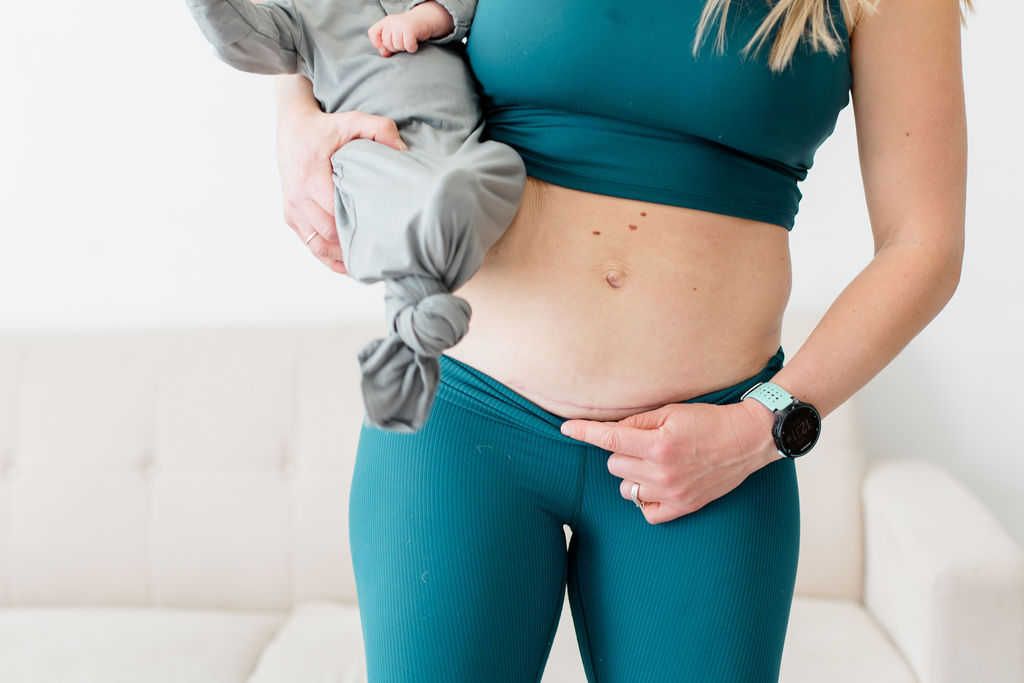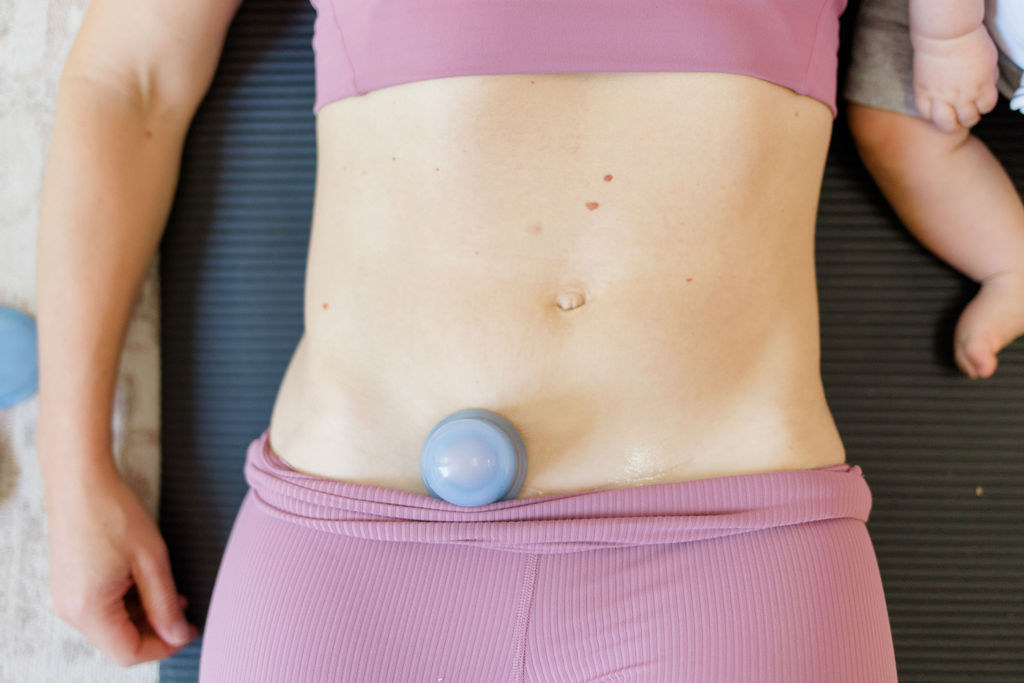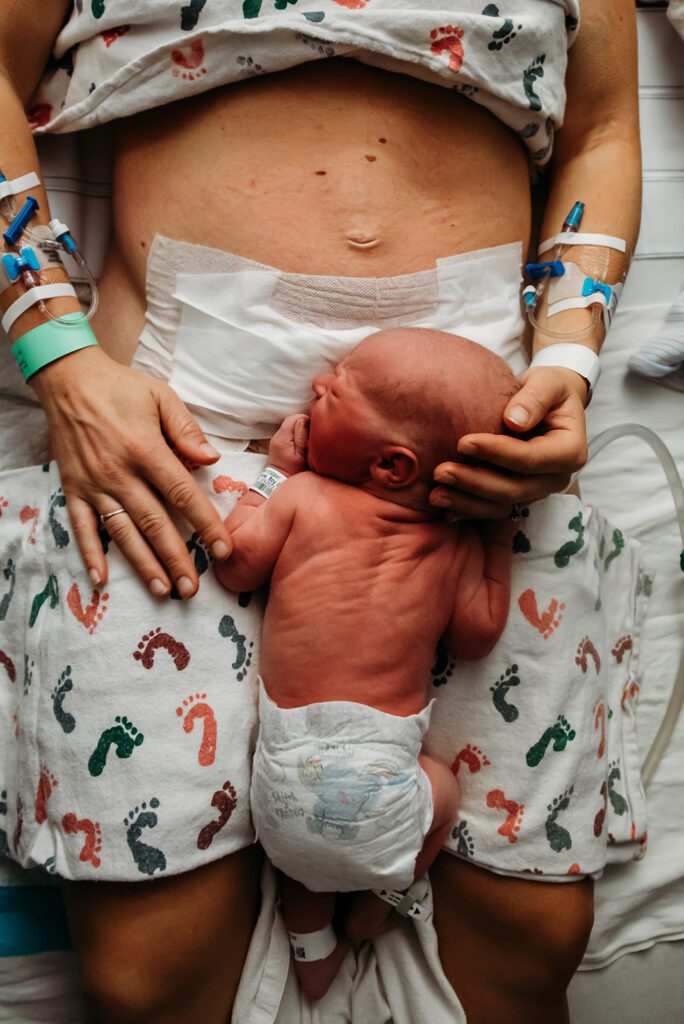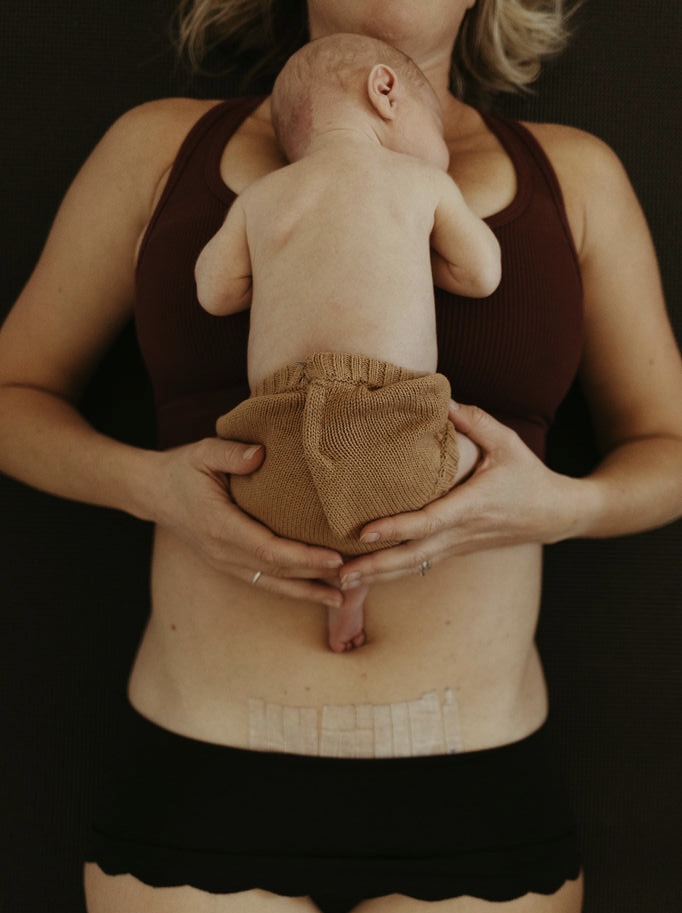“Oh, you had a C-section? At least you don’t have to worry about pelvic floor problems!”
Raise your hand if you’ve heard this before! Spoiler alert: it’s completely false. But it goes to show that pelvic floor after C-section is a topic that’s often misunderstood. It also doesn’t get nearly enough attention.
As someone who experienced pelvic floor issues after my own emergency C-section, I know firsthand how confusing and frustrating it can be when you’re dealing with unexpected symptoms such as pain and tightness.
The good news is that there’s plenty that you can do about pelvic floor issues after a C-section! I’m a Pelvic Floor Physical Therapist and a C-section mom of three, and I’ve helped hundreds of mamas rebuild and restore their pelvic floor postpartum.
What Is the Pelvic Floor?
The pelvic floor is a network of muscles between your pubic bone and tailbone.
These incredible muscles do so much for us – they support our organs (like your bladder and uterus), help control when we go to the bathroom, and play a huge role in healthy sexual function.
During pregnancy, these muscles go through a lot, regardless of how you deliver your baby. Your growing belly puts pressure on them for nine months straight, and they have to adapt to all those hormonal changes happening in your body.
C-section delivery is tough on your pelvic floor muscles as well. Here’s why.
Can You Have Pelvic Floor Issues After C-Section?
Short answer: Absolutely yes! And this is something I wish someone had told me sooner.
Here’s the thing – even though you didn’t have a vaginal delivery, your pelvic floor has still been through quite a journey.
A C-section is a major abdominal surgery, and your core muscles and pelvic floor are closely connected. When one is impacted, the other usually is too!
Before I was a Pelvic Floor Physical Therapist, I was a sports med/ortho PT, so you’d think I’d know what to expect. But I remember being so confused when I started having pain during sex after my C-section. I spent hours on Google trying to figure out what was causing my pain and what to do about it.
It wasn’t until I discovered Pelvic Floor Physical Therapy that I understood what was going on! Since then, I’ve helped hundreds of moms who felt the same way I did.
So if you’re experiencing pelvic floor issues after a C-section, you’re not imagining things! Mamas who had a C-section need pelvic floor muscle training and support, too.

Common Pelvic Floor Issues After C-Section
In a recent study, 156 out of 212 postpartum women experienced pelvic floor issues after birth, such as urinary incontinence (when you leak pee). That’s over 73%.
Whether you had a vaginal birth or a cesarean delivery, it’s very common to develop pelvic floor symptoms like pain, discomfort, tightness, and leaking.
Pelvic Floor Pain After C-Section
If your pelvic floor function is impacted after a C-section birth, you might experience:
- Sharp or aching pain in your pelvic area
- Discomfort during everyday activities
- Pain during sex
- A feeling of heaviness or pressure
Some pain in your abdomen is normal in the first few weeks after your C-section (you just had major surgery!).
But if you’re still having pain after 6-8 weeks, or if something just doesn’t feel right, it’s definitely worth getting checked out.
Surgical pain usually feels sharp and is focused around your incision. Pelvic floor pain might feel deeper and could include sensations like pressure or aching.
Watch out for red flags like severe pain that gets worse instead of better and bleeding or unusual discharge.
Tight Pelvic Floor After C-Section
Surprisingly, your pelvic floor can actually become too tight after a C-section.
Your body just went through a major surgery. Just like you might hunch your shoulders when you’re stressed, your pelvic floor typically tenses up in response to surgery and healing.
Your core was cut into, so you currently have little stability in it. Your pelvic floor muscles tighten up to try to provide support and end up overworked and tight all the time.
Plus, that scar tissue from your C-section can pull on surrounding muscles, making everything feel tight and uncomfortable.
You may feel:
- Like everything “down there” is clenched
- Pain or discomfort during sex (or even when trying to use a tampon)
- Difficulty relaxing your muscles
- Tailbone pain
- Sometimes even constipation
Tightness is a common symptom of pelvic floor dysfunction, and I help moms learn how to relax their pelvic floor in my online program Strong Core Mama!
It’s perfect for all moms, whether you had vaginal or cesarean childbirth. For my C-section mamas, the program actually has a dedicated C-section track with extra exercises and education on pelvic floor health, tips on how to reduce scar tissue adhesions, and more!
Other Common Issues
You might also experience:
- Having to rush to the bathroom more often
- Leaking pee when you laugh, cough, or exercise
- Feeling like you can’t empty your bladder completely
- Lower back pain
- Constipation
- Decreased sensation around the scar
- Feeling self-conscious or worried
Try these pelvic floor exercises to relieve these uncomfortable symptoms and increase pelvic floor muscle strength.

What Does a Weak Pelvic Floor Feel Like After Birth?
If your pelvic floor is weakened after birth, you might notice some unexpected changes: leaking when you laugh or sneeze, feeling pressure or heaviness down there, or maybe even struggling to make it to the bathroom in time.
These aren’t just “normal mom things” you have to live with – they’re signs that your pelvic floor needs some TLC.
Do You Need Pelvic Floor Therapy After C-Section?
Whether you had a vaginal birth or a C-section, your pelvic floor needs attention during recovery. Many C-section moms are surprised to learn they need the same amount of – if not more – pelvic floor support as those who delivered vaginally.
Pelvic floor rehabilitation after a C-section should focus on:
- Relaxation Exercises: It’s common for your pelvic floor muscles to get too tight after a C-section, which triggers symptoms like pain, discomfort, and leaking.
- C-Section Scar Mobilization: Your C-section scar has fascial connections to your pelvic floor. Having less mobility in the scar leads to more tension in the pelvic floor.
Seeing a Pelvic Floor Therapist can be a great option, but many moms don’t have access to a local PT or time to drive to their appointment. Cost can be a huge barrier, too.
This is why I created Stong Core Mama! It’s an online program that helps you strengthen your pelvic floor and abdominal muscles – and it has a specialized C-section track.

The education and exercises in Strong Core Mama are based on my actual experiences with hundreds of mama patients in the physical therapy clinic! They’re also informed by my own experience of rehabilitating from 3 Cesarean births.
I regularly pop in to answer questions or give more explanations, so you’re never alone in your journey!
Pelvic Floor After C-Section Recovery
Immediate Post-Surgery Period
The first few weeks after your C-section are crucial for healing. Your body just went through major surgery, and while you might be eager to “bounce back,” taking it slow is key to healthy long-term recovery.
What to expect in the first few weeks:
- You’ll feel very sore and tender around your incision
- Simple movements like getting in and out of bed might be challenging
- Your core muscles will feel like they’re pretty much…gone (or very weak)
- You might experience some bladder control issues
- Constipation
Initial movements and activities:
- Focus on gentle diaphragmatic breathing exercises
- Practice getting up and down safely and log-rolling out of bed
- Take short walks around your home
- Listen to your body and rest when needed
Rest is essential for the first two weeks, but try to do a little bit of walking or ankle pumps to prevent blood clots.
After that, you can start incorporating gentle, PT-approved exercises – but only if you’re feeling ready and have gotten the green light from your healthcare provider.
My top early postpartum exercises are all in my program Strong Healing Mama!

Long-Term Recovery
Here’s something that’s not talked about enough: you shouldn’t jump back into your previous exercise routine without properly rehabilitating your core and pelvic floor first.
I’ve seen many moms try to do too much too fast, and it only makes their pelvic floor symptoms worse.
Rebuilding your pelvic floor after a C-section takes time, but it’s entirely possible to live free of symptoms like stress urinary incontinence (leaking) and pelvic pain.
Healing your pelvic floor and rebuilding your core strength helps you get rid of diastasis recti and decrease the “c-section shelf,” too! Pelvic floor recovery is a huge piece of the puzzle for these issues.
Will Pelvic Floor Issues Just Go Away After a C-Section?
Many moms don’t realize that pelvic floor issues typically don’t resolve on their own, even years after giving birth.
If you’re dealing with leaking, pain, or tightness, don’t just wait for it to go away – there are steps you can take to improve your quality of life!
Your body is incredibly resilient, and with the right support and guidance, you can make significant improvements at any stage of your postpartum journey.

How Soon After C-Section Can You Do Pelvic Floor Exercises?
You can start gentle breathing and pelvic floor exercises approximately two weeks after delivery.
I always recommend moms focus on active rest for the first two weeks (rest with gentle movement to prevent blood clots) and then gradually start rebuilding their strength with targeted exercises.
I know it’s tempting to jump right back into your pre-pregnancy workout routine, especially if you were super active before.
I’ve definitely felt this way before! After my first C-section, I overdid it and had an unmanageable amount of pain. My healing was delayed because I fell into the trap of the “terrible too’s”: too much, too soon, too fast.
You have to remember that your body just went through nine months of pregnancy and major surgery.
Rushing back to high-impact exercises like running or HIIT workouts – even if you feel mentally ready – can put you at risk for serious issues like pelvic organ prolapse or long-term pelvic floor dysfunction.
This doesn’t mean you’ll never be able to do high-impact exercise again. On the contrary! With proper rehabilitation, you’ll become better and stronger than you were pre-baby. You also save time in the long term if you do things right at the beginning,
Be patient and give your pelvic floor what it needs to recover properly first.

FAQs
Do C-Sections Protect the Pelvic Floor?
C-sections might reduce some risks associated with vaginal delivery, but they don’t automatically protect your pelvic floor. C-section mamas also need pelvic floor rehab. It might look different, but it’s still very much needed.
First, pregnancy itself puts intense pressure on your pelvic floor muscles for months. Then there’s the actual delivery and surgery – remember, during a C-section, your abdominal tissue is separated and your organs are temporarily moved around to reach your baby. This surgical trauma, combined with the physical demands of carrying a baby for nine months and all those pregnancy hormones that loosen your joints and muscles, can significantly impact your pelvic floor function.
What Does a Damaged Pelvic Floor Feel Like?
Roughly one-quarter of American women are affected by pelvic floor disorders. You might experience heaviness or pressure in your pelvic area, leaking when you cough or exercise, and discomfort or pain during sex. These symptoms aren’t just “part of motherhood” – they’re signs that your pelvic floor needs attention.
How to Tell If Pelvic Floor Is Tight or Weak?
As a Pelvic Floor Physical Therapist, I can tell you that our society’s obsession with having a strong pelvic floor is causing a lot of harm. Many women think they need to constantly squeeze and tighten these muscles, but the majority of moms I see actually have an overactive pelvic floor that doesn’t know how to properly relax.
It’s like keeping your fist clenched 24/7 – that’s not strength, that’s tension! A pelvic floor that’s too tight and tense can cause similar symptoms to a weak one, such as discomfort, leaking, and pain during sex.
How Long Until Pelvic Floor Returns to Normal After Birth?
It depends. For some women, unwanted pelvic floor symptoms clear up shortly after birth. But many moms still experience pelvic floor issues years after giving birth. But you don’t have to accept dysfunction as your new normal. With proper support and treatment, you can improve your pelvic floor function at any stage postpartum.
How Can I Prevent Prolapse After C-Section?
Pelvic organ prolapse is when one or more of your pelvic organs (like your bladder, uterus, or rectum) starts to descend or bulge into your vaginal canal. It might feel like heaviness or pressure, or like a tampon falling out – and while it can be scary to think about, taking proper care of your pelvic floor after a C-section helps prevent this condition!
Doing pelvic floor exercises, coordinating your breathing with movement (especially any type of lifting, whether it’s lifting your kids or for exercise), and gradually building back strength are all important. I teach you how to do this in Strong Core Mama.
Do I Need to Do Kegels If I Had a C-Section?
C-section mamas need the same pelvic floor support as moms who had a vaginal delivery. Kegels can be a good exercise, but in my experience, most C-section moms don’t need Kegels – especially not right away.
Kegels tighten your pelvic floor, and in many cases, it’s already too tight after the C-section. So, Kegels can actually make your symptoms worse! It’s important to learn how to relax your pelvic floor first, and then you can add on the strengthening.
How Common Is Pelvic Floor Dysfunction Postpartum?
Pelvic floor dysfunction postpartum is very common. A study showed that 73.6% of women had symptoms of pelvic floor dysfunction at 1 year postpartum, with the most common symptoms being constipation and urinary incontinence (leaking). For many moms, pelvic floor symptoms can continue for years.
But this doesn’t mean that you should just live with it! In Strong Core Mama, I help women stop accepting pelvic floor and core weakness as their new normal.
Does Walking Help Pelvic Floor After Birth?
Walking is good for recovery! It promotes healing, helps with circulation, and gently engages your core and pelvic floor muscles. Start slow, listen to your body, and gradually increase your distance as you feel stronger. You can use my Return to Running checklist to plan your walk/run workouts!
But walking isn’t ALL you need to restore and rebuild your pelvic floor after a C-section. It’s good, but it’s not the whole picture.
Can a C-Section Cause Pelvic Floor Dysfunction?
C-sections themselves don’t directly cause pelvic floor dysfunction, but the combination of pregnancy, major abdominal surgery, and postpartum recovery can affect your pelvic floor and cause uncomfortable symptoms like pain, tension, leaking, and pressure. Scar tissue formation and changes in movement patterns can also impact how these muscles work.
What Does Postpartum Prolapse Feel Like?
Pelvic organ prolapse might feel like pressure or heaviness in your vagina, a sensation that something is falling out, or discomfort that gets worse as the day goes on. If you’re experiencing these symptoms, don’t panic! Sometimes, a functional pelvic floor routine can help you get better. There is also pelvic organ prolapse surgery available for severe cases, but research shows that 58% of people who have prolapse surgery need a second surgery UNLESS they do pelvic floor rehab BEFORE they get the first surgery done.
How to Strengthen Pelvic Floor After C-Section?
To achieve full strength, you need to first learn how to RELAX your pelvic floor. That’s the most common problem I see as a Pelvic Floor Physical Therapist. Start with gentle exercises and focus on the connection between your breath and the pelvic floor. As you heal, gradually progress to more targeted exercises that coordinate your pelvic floor with the other important muscle groups. I help you do this in Strong Core Mama!
Get Support From a Pelvic Floor PT After C-Section
Your body did something amazing creating and birthing your little one.
As a C-section mama, you may have felt isolated or shamed for how your baby entered the world or been told that your birth was the “easy way out”. As a C-section mama myself, I’ve had to deal with this, too.
Many cesarean moms are surprised when they experience pelvic floor issues after birth. This was my personal experience, too.
This is why my program Strong Core Mama has a dedicated C-section track that teaches you how to decrease common pelvic floor symptoms, minimize pelvic floor tightness and pain, and more.
Learn more about Strong Core Mama!
